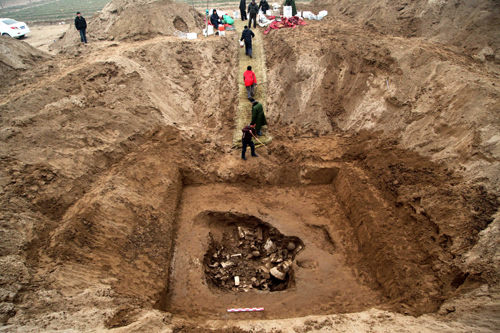|
 |
|
EXCAVATION: A buried pit is found by archeologists at the Yecheng Relics Site in Hebei Province (CFP) |
On March 19, archeologists of the Chinese Academy of Social Sciences (CASS) announced in Beijing that they had discovered nearly 3,000 Buddha statues dating back to the Eastern Wei Dynasty (534-550) and the Northern Qi Dynasty (550-577) at the Yecheng Relics Site. Yecheng is a 2,500-year-old ancient city located in what is now Linzhang County in north China's Hebei Province. The number of Buddha statues unearthed in this pit is the largest find in the past seven decades in China.
The archeological excavation, which began on January 10 this year, was jointly made by the Institute of Archeology of the CASS and the Hebei Provincial Cultural Relics Institute. Through preliminary investigations, the team found a huge pit filled with Buddha statues. About 2,895 Buddha icons and thousands of unnumbered fragments have been catalogued. Most of the statues are made of white marble and a few of bluestone. Procedures for color protection, consolidation, fragment assembly, and a series of preservation plans amount to a massive undertaking.
"It is the largest excavation of Buddha statues since the founding of the People's Republic of China in 1949, providing valuable physical evidence for the study of the transmission and development of Buddhism in China," said Zhu Yanshi, head of the exploration team in a press conference. Zhu is a research fellow at the Institute of Archeology of the CASS.
"We have been looking for the outer wall relics of ancient Yecheng for several years," Zhu said.
Zhu said the discovery was significant for four principal reasons.
First, archeologists are able to make a precise judgment of the location of the pit. It is situated inside the south wall of Yecheng. The earth layers and archeological features are clear, providing clues for archeologists to understand the construction, scale and evolution of ancient Yecheng. The discovery may also provide clues for other archeological studies of Yecheng.
Second, the sheer volume of the statues, 2,895, is exceptional. All the Buddha statues are buried at distinct locations, showing that the damage to the icons was organized, systematic and on a large scale. It provides archeologists with more evidence to study Buddhist icon demolition movements and the practice of burying desecrated statues during these periods of history.
Third, the unearthed statues have a range of themes and sizes and demonstrate exquisite craftsmanship. Many of the statues are screen-backed. The figures depicted are remarkably diverse including Sakyamuni, Amitabha, Maitreya, and Avalokitesvara. The statues vary in size from 20 cm long to the size of an actual person, said Zhang Wenrui, an official with the Hebei Provincial Cultural Heritage Bureau. Most of them have traces of their original color and gold leaf, even though more than 1,000 years have passed. The discovery supports Yecheng's status as a center of Buddhism and culture in the northern part of China during the late Northern Qi Dynasty.
| 